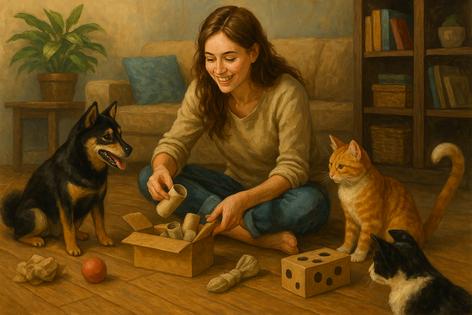DIY Enrichment Toys Using Household Items
Published in Cats & Dogs News
Enrichment isn’t just for zoo animals—our cats and dogs benefit from it too. Providing mental stimulation helps prevent boredom, reduces anxiety and can even curb unwanted behaviors. But pet owners don’t need to spend a fortune on store-bought gadgets. Many of the best enrichment toys can be made at home with common household items, a little creativity and a good sense of what excites your pet.
Why enrichment matters
Mental stimulation is as vital as physical exercise for pets. Dogs and cats both evolved to problem-solve and work for their food, whether by hunting, foraging or navigating new environments. When those instincts go unused, it can lead to frustration, lethargy or even destructive behavior.
For dogs, enrichment can reduce barking, digging and pacing. For cats, it helps alleviate stress-related behaviors like overgrooming or aggressive play. It also helps strengthen the bond between pets and their owners, especially when the activities involve shared play.
Simple toys from recycled materials
One of the easiest enrichment tools is a treat puzzle made from a cardboard box or toilet paper roll. Dog owners can drop a few kibble pieces into a toilet paper tube, fold in the ends and let their pup paw or gnaw it open. For cats, small boxes filled with paper scraps and hidden treats offer hours of foraging fun.
Plastic bottles can also be transformed into food dispensers. With supervision, a clean, dry bottle can be filled with kibble and have holes poked in the sides just large enough for the food to fall through when batted or rolled. Dogs enjoy this kind of challenge, especially when the toy moves unpredictably.
Sock toys are another popular homemade option. Fill a sock with crinkly material like old plastic bags or paper, tie off the end and give it to a curious cat. Add a sprinkle of catnip to take things to the next level.
Interactive play that engages the senses Not all enrichment needs to be food-based. For dogs, a towel or blanket rolled up with treats inside makes for an excellent snuffle mat. Cats can enjoy the thrill of “hunting” by chasing a wand toy made from string and a feather tied to a stick. Even an empty paper bag or cardboard box can become a miniature playground when left out for a cat to explore.
Scent enrichment also goes a long way. Try hiding different smells around the house—like a drop of vanilla on one toy and lavender on another—and let your pet sniff out each one. Dogs especially benefit from nosework, and it taps into their strongest natural instinct.
Safety first
While homemade toys are affordable and fun, it’s important to ensure they’re safe. Avoid anything your pet might easily swallow or choke on, like buttons, rubber bands or strings longer than six inches. Always supervise your pet the first time you introduce a new DIY toy and remove anything that shows signs of breaking or splintering.
Make sure plastic containers don’t have sharp edges, and never use cleaning supply bottles, even if washed. Stick to food-safe items whenever possible, and wash toys regularly to prevent bacteria buildup.
Tailoring toys to your pet
Not every pet is motivated by the same things. Some dogs will happily shred a cardboard box, while others may be more food- or scent-driven. Cats that ignore puzzles might light up for a moving feather or a rustling paper tunnel. Try different combinations and observe what sparks your pet’s interest.
The goal isn’t perfection—it’s engagement. Even if your pet spends only a few minutes exploring a new toy, that’s still a meaningful break from routine and a boost to their well-being.
Turning trash into tail wags
DIY enrichment is about more than saving money. It’s about understanding your pet’s needs and giving them a chance to think, explore and have fun. With just a few everyday materials, a little time and some playful imagination, you can turn yesterday’s recycling into today’s tail-wagging adventure—or a purring pile of satisfaction curled inside a crinkly paper bag.
========
This article was created, in part, utilizing AI tools.









Comments